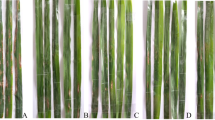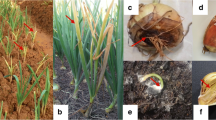Abstract
Greenhouse experiments confirmed that both Botrytis cinerea and B. fabae could infect lentil and cause Botrytis grey mould symptoms. Experiments were conducted under controlled environments to determine the effects of temperature, leaf wetness duration, plant age and inoculum concentration on infection of lentil by B. cinerea. Optimum conditions for infection and sporulation were defined at 15–25°C, with limited sporulation at 10°C but no sporulation at 5°C or 30°C. Sporulation occurred 6–7 days after inoculation when leaf wetness was constantly maintained using humidity tents. Absence of leaf wetness for up to 4 weeks following inoculation did not reduce the disease severity, but reduced the time to sporulation to 3 days after leaf wetness was returned. Increasing the age at which plants were inoculated, from 6 to 18 weeks, had no significant effect on disease severity. Senescent and mature plant material acted as a focus for infection and sporulation. Increasing inoculum concentration from 5×104 conidia/mL to 5×106 conidia/mL significantly increased the number of plants infected, independent of genotype resistance. No disease developed at the lowest concentration of 5×102 conidia/mL.
Similar content being viewed by others
References
Bahl PN, Lal S, Sharma BM (1993) An overview of the production and problems of lentil in South Asia. In ‘Lentil in South Asia’. (Eds W Erskine, MC Saxena) pp. 1–10. (ICARDA: Aleppo, Syria)
Bailey KL, Gossen BD, Derksen DA, Watson PR (2000) Impact of agronomic practices and environment on diseases of wheat and lentil in southeastern Saskatchewan. Canadian Journal of Plant Science 80, 917–927.
Bayaa B, Erskine W (1998) Diseases of lentil. In ‘The pathology of food and pasture legumes’. (Eds DJ Allen, LM Lenné) pp. 423–472. (CAB International: Wallingford, UK)
Beever RE, Weeds PL (2004) Taxonomy and genetic variation of Botrytis and Botryotinia. In ‘Botrytis: biology, pathology and control’. (Eds Y Elad, B Williamson, P Tudzynski, N Delen) pp. 29–52. (Kluwer Academic Publishers: Dordrecht, The Netherlands)
Davidson JA, Materne M, Lindbeck KD, Krysinska-Kaczmarek M, Hartley D (2004) Understanding Botrytis grey mould of lentils in Australia and identifying useful resistance. In ‘Proceedings of the 5th European grain legumes conference, Dijon, France’. pp. 83–84.
Davidson JA, McMurray L, Nitschke S, Lindbeck K, Krysinska-Kaczmarek M (2005) Influence of spring rain on botrytis grey mould in southern Australian lentils. In ‘Proceedings of the 15th biennial Australasian plant pathology conference, Geelong, Victoria, Australia’. p. 232.
Dennis DI (1991) Chocolate spot of faba beans in South Australia. MSc Thesis, University of Adelaide, Australia.
Elad Y, Yunis H, Katan T (1992) Multiple resistance to benzimidazoles, dicarboximides and diethofencarb in field isolates of Botrytis cinerea in Israel. Plant Pathology 41, 41–46. doi: 10.1111/j.1365-3059.1992.tb02314.x
Ellis MB, Waller JM (1974a) ‘Sclerotinia fuckeliana (conidial state: Botrytis cinerea). CMI descriptions of pathogenic fungi and bacteria. No. 431.’ (Commonwealth Mycological Institute: Kew)
Ellis MB, Waller JM (1974b) ‘Botrytis fabae. CMI descriptions of pathogenic fungi and bacteria. No. 432.’ (Commonwealth Mycological Institute: Kew)
Elmer PAG, Michailides TJ (2004) Epidemiology of Botrytis cinerea in orchard and vine crops. In ‘Botrytis: biology, pathology and control’. (Eds Y Elad, B Williamson, P Tudzynski, N Delen) pp. 243–262. (Kluwer Academic Publishers: Dordrecht, The Netherlands)
Erskine W, Tufail M, Russell A, Tyagi MC, Rahman MM, Saxena MC (1994) Current and future strategies in breeding lentil for resistance to biotic and abiotic stresses. Euphytica 73, 127–135. doi: 10.1007/BF00027189
Fitt BDL, Creighton NF, Bainbridge A (1985) Role of wind and rain in dispersal of Botrytis fabae conidia. Transactions of the British Mycological Society 85, 307–312.
Haware MP (1998) Diseases of chickpea. In ‘The pathology of food and pasture legumes’. (Eds DJ Allen, LM Lenné) pp. 473–516. (CAB International: Wallingford, UK)
Holz G, Coertze S, Williamson B (2004) The ecology of Botrytis on plant surfaces. In ‘Botrytis: biology, pathology and control’. (Eds Y Elad, B Williamson, P Tudzynski, N Delen) pp. 9–27. (Kluwer Academic Publishers: Dordrecht, The Netherlands)
Iqbal SM, Hussain S, Malik BA (1992) In vitro evaluation of fungicides against Botrytis cinerea of lentil. Lens Newsletter 19, 49–51.
Jarvis WR (1962) Splash dispersal of spores in Botrytis cinerea Pers. Nature 193, 599. doi: 10.1038/193599a0
Jarvis WR (1980a) Taxonomy. In ‘The biology of Botrytis’. (Eds JR Coley-Smith, K Verhoeff, WR Jarvis) pp. 1–17. (Academic Press: London)
Jarvis WR (1980b) Epidemiology. In ‘The biology of Botrytis’. (Eds JR Coley-Smith, K Verhoeff, WR Jarvis) pp. 219–249. (Academic Press: London)
Kaiser WJ (1992) Fungi associated with the seeds of commercial lentils from the U.S. Pacific Northwest. Plant Disease 76, 605–610.
Karki PB (1993) Plant protection of lentil in Nepal. In ‘Lentil in South Asia’. (Eds W Erskine, MC Saxena) pp. 187–193. (ICARDA: Aleppo, Syria)
Lindbeck KD, Materne MA, Davidson JA, McMurray L, Panagiotopoulos K (2002) Lentil Disease Management Strategy for Southern Region GRDC. Pulse Australia: disease management guide series, Sydney, Australia.
Lindbeck KD, Bretag TW, Materne MA (2003) Breeding for resistance to Botrytis Grey Mould in Australian lentil. In ‘Proceedings of the 8th international congress on plant pathology, Christchurch, New Zealand’. p. 291.
McKenzie BA, Hill GD, White JGH, Meijer G, Sikken G, Nieuwenhuyse A, Kausar AG (1986) The effect of sowing date and population on yield of lentils (Lens culinaris Medik.). Proceedings of the Agronomy Society of New Zealand 16, 29–33.
Morrall RAA (1997) Evolution of lentil diseases over 25 years in western Canada. Canadian Journal of Plant Pathology 19, 197–207.
Morrall RAA, Paisley J, French M (1994) Seed-borne diseases of lentil in Saskatchewan in 1993. Canadian Plant Disease Survey 74, 101.
Nene YL, Reddy MV, Haware MP, Ghanejar AM, Amin KS (1991) Field diagnosis of chickpea diseases and their control. Information Bulletin 28, 1–52.
Singh KB, Hawtin GC, Nene YL, Reddy MV (1981) Resistance in chickpea to Ascochyta rabiei. Plant Disease 65, 586–587.
Tufail M, Malik IA, Choudhary M, Ashraf M, Saleem M (1993) Genetic resources and breeding of lentil in Pakistan. In ‘Lentil in South Asia’. (Eds W Erskine, MC Saxena) pp. 58–75. (ICARDA: Aleppo, Syria)
Walter M, Boyd-Wilson KSH, Perry JH, Elmer PAG, Frampton CM (1999) Survival of Botrytis cinerea conidia on kiwifruit. Plant Pathology 48, 823–829. doi: 10.1046/j.1365-3059.1999.00413.x
Author information
Authors and Affiliations
Corresponding author
Rights and permissions
About this article
Cite this article
Davidson, J.A., Krysinska-Kaczmarek, M. Effects of inoculum concentration, temperature, plant age and interrupted wetness on infection of lentil (Lens culinaris) by Botrytis spp. conidia. Australasian Plant Pathology 36, 389–396 (2007). https://doi.org/10.1071/AP07039
Received:
Accepted:
Issue Date:
DOI: https://doi.org/10.1071/AP07039




